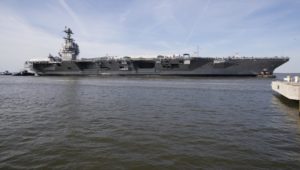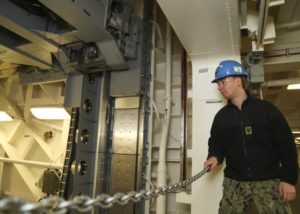The Secretary of the Navy today said the cost cap on the first Ford-class aircraft carrier helped lead to problems resulting in delays to the advanced weapons elevators (AWEs) and explained the government’s issues and changing strategy with the shipbuilder.
Secretary of the Navy Richard Spencer said on Wednesday at a Heritage Foundation press roundtable that the Navy and shipbuilder/AWE builder Huntington Ingalls Industries [HII] planned to build a test elevator site, similar to the electromagnetic advanced landing system (EMALS) located in Lakehurst, N.J.

The Navy has used Joint Base McGuire-Dix-Lakehurst to test the General Atomics advanced arresting gear (AAG) and EMALS hundreds of times before testing them on the first new carrier, the USS Gerald R. Ford (CVN-78).
“Then we had the cost cap come in. And as [HII president and CEO] Mike Petters can say, you know fine, the cost cap comes in and no one builds the land site elevator. We had to cut costs somewhere. Sometimes we’re our own worst enemy,” Spencer said.
In February, the Navy said it would start building the AWE land-based test site, after the fact, in Philadelphia (Defense Daily, Feb. 20).
Spencer said he thinks about it and wonders if anyone was expecting there to be second and third order effects of a cost cap.
“You don’t get anything for free and you’re not going to drive quality by cost cap. We have to start thinking differently when we go to cost control.”
Spencer also further illuminated the Navy’s work with HII on the elevators. Last week, he strongly criticized the company after delays on the AWEs, saying the Navy’s faith and confidence with HII senior management on the project were very low (Defense Daily, Oct. 25).
On Monday, Assistant Secretary of the Navy for Research, Development and Acquisition James Geurts said the Navy-HII team’s output on the elevators has been much better in the last few months and he was cautiously optimistic on progress of the Ford elevators (Defense Daily, Oct. 29).
Spencer said in fall 2018 the Navy was finalizing the HII elevator plan. The company gave him a chart that said all 11 AWEs would be tested and certified by the end of the planned post-shakedown availability (PSA), which was then planned for July 15.
He said HII management reported high confidence of this timeline while Naval Reactors told him due to throttle and bearing issues the PSA would likely be pushed into September or October, “so I had more margin there. Did I feel confident? Completely confident.”
Then, in January, Spencer said he made a bet with President Trump that the AWEs would be finished with the PSA or he could be fired (Defense Daily, Jan. 8).
Spencer explained this was meant to rally the shipbuilders.
“What we weren’t seeing down there was the spring in the step of the people on the waterfront, to be very frank with you. It was business as usual. So we said ok, here’s a rally point, we’re going to commit to this.”
However, in May 2019 he said HII management “goes oops, here we are, elevators aren’t going to be ready until the end of 2020, possibly 2021. And that’s when I went, do they really know what they’re doing?”
Spencer called that a moment of inflection and called Thomas Fargo, chairman of the board of HII, asking if the board knew what was going on with management “because out trust and confidence on this specific project of the elevators has eroded significantly.”
While Spencer said Fargo said yes, there were continued frustrations on the government side.

“That’s when Hondo [Geurts] and I said let’s get a tiger team down there and let’s take this over as the general contractor and HII can sub to us. And that’s basically what’s happened this last 3 months.”
Spencer said he went to the president and, after explaining the situation, was told “it’s a complex system, keep knocking down the dragons.”
When asked if these lessons would apply to future ships, Spencer said the Navy wants to avoid a cost cap for the lead ship in a new class like upcoming guided-missile future frigate, FFG(X).
“We have to have an open discussion on first of class. Now, these are proven designs so it’s going to be a little different, but we are adjusting it here and there and yes we should expect some hiccups,” he continued.
“Expectation management, I think, is key.”
Going forward, Spencer argued perhaps the Navy should make requirements for ships more flexible. He compared the Navy’s process to the airline industry, which requires an airplane that can fit a certain number of people to transport them a certain amount of miles and has few change orders, then examines the options.
However, the government has shrunk the competitive base so far that contractors agree to following requirements but only if the government takes 60 to 100 percent of the risk.
“In some cases, you’d love to say should we change requirements to requests? Because if in fact you’re a shipbuilder, why should I definitively lock you in if you have better ideas? Where is the flow to say if you want to get here you might want to consider this, which his 80 percent of the solution versus I will drive to 100% of your solution but the cost is going to be up here?”
Spencer said he understands it is difficult to change requirements because they serve a definite purpose but wondered at what cost and percent mission capability can the government make a compromise compared to the current inflexibility.
Relatedly, Spencer said he has “medium confidence” that a recent $197 million reprogramming request to Congress to fund more Ford fixes will be enough, simply because “first of classes is tough.”
“I’d be remiss if I said that was the last, to be very frank. I’d rather have the option to say we’re going to come for more than saying no we’re capped off now. I feel good on what we’re finally learning on the end of this birthing process,” Spencer said.